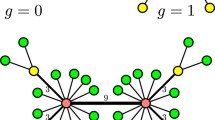Abstract
We use the methods of quantum chaos and Random Matrix Theory for analysis of statistical fluctuations of PageRank probabilities in directed networks. In this approach the effective energy levels are given by a logarithm of PageRank probability at a given node. After the standard energy level unfolding procedure we establish that the nearest spacing distribution of PageRank probabilities is described by the Poisson law typical for integrable quantum systems. Our studies are done for the Twitter network and three networks of Wikipedia editions in English, French and German. We argue that due to absence of level repulsion the PageRank order of nearby nodes can be easily interchanged. The obtained Poisson law implies that the nearby PageRank probabilities fluctuate as random independent variables.
Similar content being viewed by others
References
S. Brin, L. Page, Comput. Networks and ISDN Systems 30, 107 (1998)
A.M. Langville, C.D. Meyer, Google’s PageRank and Beyond: The Science of Search Engine Rankings (Princeton University Press, Princeton, 2006)
S. Redner, Phys. Today 58, 49 (2005)
F. Radicchi, S. Fortunato, B. Markines, A. Vespignani, Phys. Rev. E 80, 056103 (2009)
A.O. Zhirov, O.V. Zhirov, D.L. Shepelyansky, Eur. Phys. J. B 77, 523 (2010)
Y.-H. Eom, K.M. Frahm, A. Benczur, D.L. Shepelyansky, Eur. Phys. J. B 86, 492 (2013)
Y.-H. Eom, D.L. Shepelyansky, PLoS ONE 8, e74554 (2013)
L. Ermann, D.L. Shepelyansky, Acta Phys. Pol. A 120, A158 (2011)
G.W. Stewart, Matrix Algorithms Volume II: Eigensystems (SIAM, 2001)
K.M. Frahm, D.L. Shepelyansky, Eur. Phys. J. B 76, 57 (2010)
K.M. Frahm, D.L. Shepelyansky, Eur. Phys. J. B 85, 355 (2012)
L.D. Landau, E.M. Lifshitz, Statistical Mechanics (Nauka, Moskva, 1976) (in Russian), Vol. 5
M.L. Mehta, Random Matrices (Elsevier-Academic Press, Amsterdam, 2004)
F. Haake, Quantum Signatures of Chaos (Springer, Berlin, 2010)
L. Bunimovich, Scholarpedia 2, 1813 (2007)
O. Bohigas, M.-J. Giannoni, C. Schmit, Phys. Rev. Lett. 52, 1 (1984)
H.-J. Stöckmann, Scholarpedia 5, 10243 (2010)
S. Vigna, http://vigna.di.unimi.it/
K.M. Frahm, Y.-H. Eom, D.L. Shepelyansky, arXiv:1310.5624 [physics.soc-ph] (2013)
Author information
Authors and Affiliations
Corresponding author
Rights and permissions
About this article
Cite this article
Frahm, K.M., Shepelyansky, D.L. Poisson statistics of PageRank probabilities of Twitter and Wikipedia networks. Eur. Phys. J. B 87, 93 (2014). https://doi.org/10.1140/epjb/e2014-50123-4
Received:
Revised:
Published:
DOI: https://doi.org/10.1140/epjb/e2014-50123-4




